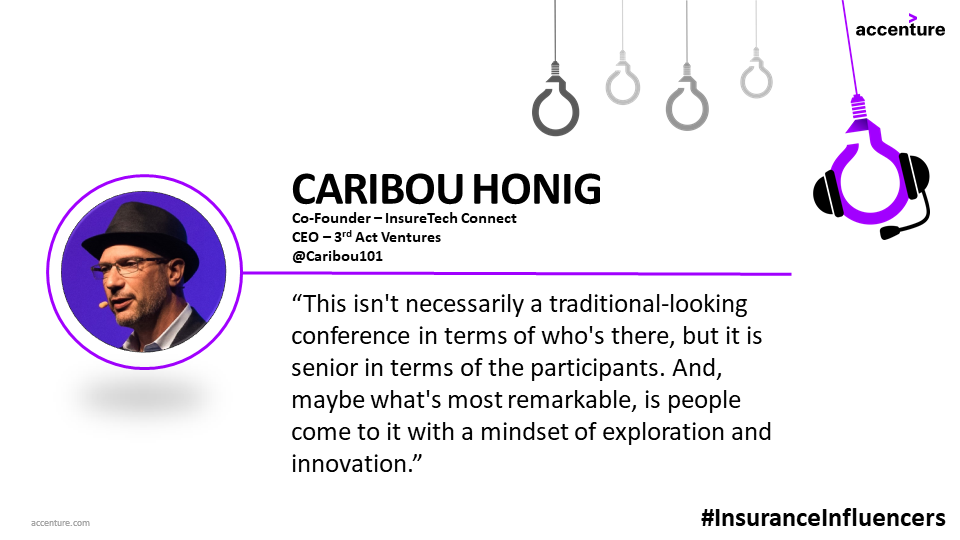Other parts of this series:
Caribou Honig is the co-founder and chairman of InsureTech Connect. In this interview, he looks at the state of the industry, how a harebrained scheme became the go-to insurtech conference—and why it’s time for start-ups to prove themselves.
Highlights
- The first wave of insurtech start-ups are at a point of proving that their products actually work—and demonstrating good economics for themselves and their stakeholders.
- Not all insurtechs will survive—according to Caribou, “most of them will die out.”
- Trends to watch include the relationship between technology, cost curves and the drivers of transformation; APIs; embedded insurance; and channel partnerships as a way to introduce new categories and products.
Season two of the Accenture Insurance Influencers podcast
Welcome back to season two of the podcast. This season, we’ll be taking a deep dive into insurtech. Every two weeks, we publish an interview with an insurtech founder, VC or thought leader with the aim of learning: How are these industry vanguards harnessing change and using it to create a more dynamic future for themselves?
Last week we kicked off the season with a look at Trov. Founder and serial entrepreneur Scott Walchek shared what he’s learned about the insurtech world; why Trov has pivoted from its on-demand direct-to-consumer application; and why the company is now focusing on autonomous vehicles and bank partnerships.
The evolution of insurtech, with Caribou Honig
Insurtech players will be familiar with Caribou Honig as the fedora-wearing chairman and co-founder of InsureTech Connect (ITC), as well as the chairman of HR Transform. Recently, he spoke to us about all things insurtech, from emerging trends to a philosophical look at the social implications of insurtech. In fact, we had so much to talk about that we’ll be publishing several episodes with Caribou throughout the season.
In this first episode, he looks at the current state of insurtech—and gives us a teaser for what to expect at ITC2019, taking place September 23–25 in Las Vegas.

The following transcript has been edited for length and clarity.
Welcome back to season two of the podcast. I’m Eagranie Yuh, and today I’m speaking with Caribou Honig, the co-founder and chairman of InsureTech Connect, and chairman of HR Transform. I’m really looking forward to our conversation. Shall we get started?
I’d be delighted.
You spent ten years at Capital One, an organization known for its data-driven focus; and from there you co-founded QED Investors, a venture capital firm focused on data-driven companies. Given that background, what are you seeing in the insurance industry right now?
I think there’s a bunch of interesting trends. Some, I get more obsessed with than others.
- Parametric insurance, where the payouts are triggered by some objective third-party data feed, for some sort of incident. I like that a lot. It’s still ramping up and it may be my great white whale that never really takes off to its fullest the way I think it should.
- APIs. I’ve really been obsessed lately with APIs and the API-ification of the insurance stack. I think that’s got big implications for insurance, whether insurtech or incumbents.
- Cost curves. I’ve recently started thinking about the entire technology-driven change in insurance as a question of cost curves. And I fear that starts to get really, really nerdy, even more than my usual nerdy level. But I’m just starting to think about well, everything out there, from a technology perspective from the information age, whether it’s processing power, whether it’s more applied things like cloud storage, or the cost of a given amount of functionality of a smartphone. Getting a satellite image, the cost of that’s going down; the cost of sequencing the genome is falling dramatically. A lot of cost of labor can start to get replaced by software or machine intelligence. A perspective of looking at the technology trends impacting insurance as a set of cost curves is maybe an interesting language to look at.
And I understand you’ve collected a library of APIs.
So I’ve got a side project called InsurAPI.io. It seems like there should be a catalog of all the APIs related to insurance collected in one location, so that if you are creating an API and you want to let the world know about it, you just let the world know about it through InsurAPI.io. Or if you’re trying to build something and you want to find what APIs already exist, you can just tap into, so you don’t have to rebuild it, you just go to one place, InsurAPI.io, and you find it.
And strangely it didn’t seem to exist, but seemed like it would be useful. And so I’m in a process with a couple of folks I know to try to create it. So right now we’re in a rough beta, and over the course of the next couple months, I’m hoping that it will become really quite functional and start to be useful for people.
At InsureTech Connect, you’ve opened up your past keynotes by looking at some of the big industry trends. Last year [2018], you talked about a Cambrian explosion in insurtechs. Can you talk a little bit about that?
Yeah, I’m always happy to. Now, I’ll start for folks who aren’t aspiring biologists. It’s a reminder that the Cambrian explosion was like 500, 550 million years ago. And it’s really where complex organisms started to emerge and sort of went from lots and lots and lots of single-celled animals to, “Oh look, there’s a complex trilobite swilling all around. Isn’t that interesting.” But really, many different forms of life were tried out at that moment and that gave rise to a whole lot of interesting successful forms of life thereafter.
I think the Cambrian explosion we’re seeing in insurtech started about three or four years ago, not 500 million years ago. But really, I see this explosion of interesting new ideas and new types of companies and business models and products and data all emerging seemingly out of the great primordial soup of insurance.
That’s really interesting because it’s really hard, even if you’re a VC, to predict which one, or which body type, of start-up is going to succeed. But it’s a little easier to be able to make the claim that some of them are going to succeed and that’s what it feels like. I may not know whether it’s going to be mammals or Tyrannosaurus Rex that emerges out of the Cambrian explosion, but it sure feels like something on a couple of legs is probably going to have a pretty good outcome.

Right. And as we’re recording this, Lemonade recently announced a bid for IPO with an estimated $2 billion valuation. I don’t necessarily want to get into the specifics of that, but rather to talk about different routes for these insurtechs, so IPOs, M&A, MGAs that take on more of the risks themselves. What are these possible for these little or medium-sized companies? What are the options?
You know, I’ll start by saying, “…and most of them will die out,” which is an important backdrop.
Part of it can be the venture capital math that’s in my head, right? Success for this Cambrian explosion does not mean nine out of ten of these start-ups have to succeed. It means two or three out of ten need to do pretty well, at least make their investors some money. Maybe one in ten do really, really well, give their investors a 10x or 30x outcome. And that means, by the way, that more money will then come into the sector and be recycled and it’ll continue to have its proliferation of new companies, new start-ups coming out of it.
But that still suggests a third will fail, and a third will kind of capitulate and just become bolted on to some other company that has a working business model, and that’s fine.
I think that of the ones that are going to be eventual winners… Look there’s two types, there’s a fundamental split.
- There’s the B2B companies, the ones that are trying to sell into insurance incumbents. They’re enterprise-facing start-ups, they are trying to help the incumbents become better, faster, more efficient, more customer-friendly, whatever.
- And then there’s the customer-facing start-ups. Think of Lemonade, as a well-described customer-facing start-up. They’re not trying to sell into Allianz; if anything, it’s the other way around.
The customer-facing ones like a Lemonade or Metromile, they’re trying to get the insurance incumbents into their supply chain, whereas the B2B ones are trying to become part of the supply chain of the current insurance giants. Both are legitimate ways to go to market of course, but they have different pros and cons.
In terms of exits, IPOs are wonderful. They are, first and foremost, they are a financing event. They are not the destination. And that’s why great entrepreneurs don’t get wrapped up around, “hey, my goal is to IPO.” If your goal is to IPO, that makes for a much less interesting company. If your goal is to build a great company and that may end up becoming part of some other company, or it may end up being standalone, may stay private for many years––those are all fine.
I think the key is how are these companies building fundamentally good economics for themselves and for their stakeholders. That second part is equally important. A great company—a sustainable company—is not going to just build great profitability for itself, it’ll be building a great value proposition for its customers, whether enterprises or consumers. And it will be really great for its own supply chain. If you are a customer-facing, new insurtech start-up and you’re working with a reinsurer, part of your job in building it into a sustainable business is making sure that reinsurers get good returns too. As well as making sure that those customers are getting a great insurance product.

It’s curious because at your 2017 keynote, at the end of your comment on Cambrian explosion, you said, “with few exits so far.” So what I’m hearing is that you do expect quite a lot of exits to come, a third of the industry.
I do. I’ve become very optimistic, actually, in the last 12 months. If you’d asked me 12 months and a day ago, I would’ve said, “I think that this insurtech thing is going to prove to be valuable. But there’s a real scenario in my mind that I worry about where it doesn’t.”
At this point the things I’ve seen, I feel like yes, there’s clearly some valuable companies being created, in both the B2B and the customer-facing side of things. Maybe not always the buzziest companies, but I do think that there are quite a few companies that are building real, sustainable economics, and are pursuing strategies that will, over time, deliver scale and are thus creating real economic value, either as a standalone in the long term, or something that is valuable in the hands of someone else.
We’re now, call it three years since the Cambrian explosion began and the first wave of modern insurtechs started getting early-stage funding. Now is just about the time where you’d expect them to start demonstrating the really interesting economics, because first you’ve got to get the funds, then you’ve got to start building out the product, then you’ve got to build out partnerships. And in insurance, even with the relatively good willingness of the insurance value chain, the insurance incumbents, to actually experiment and engage with the start-ups, lighting up a new product actually does take quite a long time in insurance––for many good reasons. It’s complex. There’s regulatory hurdles. There’s real risk that you need to manage here.
But now is about the time when the first wave of start-ups should be at the point of proving that what they’ve been building actually works. And so the next 12 to 24 months; I will say, if that first wave of insurtechs doesn’t start to have some clear winners when it comes to fundamentals, then there is a real problem.
But I’m actually quite optimistic from the bits and pieces I’ve seen and triangulated into, that there’s at least a good fraction that are building something real and interesting.

Cool. Well it’ll be an interesting 12 to 24 months to see how that plays out. Another one of your harebrained schemes that seems to have taken off, InsureTech Connect, kicks off September 2019. Forgive me, I don’t have the dates in front of me but…
September 23rd to 25th.
There you go. In Vegas?
Yes, at the MGM.
Last year it had more than more than 5000 attendees. Is that right?
That’s right. In our first year we had 1500, it went 3500. Last year was 5500. Our best guess is it will be somewhere around 7500 this year.
Wow. I mean, that’s pretty impressive for a harebrained scheme. What do you attribute to this tremendous pickup in support of ITC?
I like to say that in the course of a person’s career they’ll probably have three or four really good ideas. And this was certainly one of my three or four best that I think I’ll ever have. This really was a case of building something for a focus group of one. And as funny as that sounds, that actually is a key to why it succeeded.
I needed to go to this thing, so I found a fellow who’s now become a great business partner with me, Jay Weintraub, to help bring this notion to life. And we built it to be the kind of conference that I would want to go to with my venture capital hat on, meeting other investors, and meeting the entrepreneurs, and meeting the innovation executives across the industry.
I think that helped with the execution of it quite a lot. Making sure that it really was very business-focused, very outcome-focused, a place where business actually can get done. Certainly I think we benefited from our timing as well. We couldn’t really find anything else out there quite like it. And it certainly coincides with the Cambrian explosion.
It’s really meant to be very inclusive of all categories of insurance, all parts of the value chain for insurance as well. And I think that we actually did a pretty nice job, if I can pat myself on the back, around also making it expansive on the diversity and inclusion; bringing in the new talent. We had some scholarships, so to speak, for some students to attend. We really made sure that this isn’t your grandfather’s Oldsmobile.
This isn’t necessarily a traditional-looking conference in terms of who’s there, but it is senior in terms of the participants. And, maybe what’s most remarkable, is people come to it with a mindset of exploration and innovation. And I think context matters, because I think you could have many of the same people attending a different event without the same context and they wouldn’t be as keen to take new introductions and meet people that they haven’t met before.
But I think that we managed to set the context for the event so that people are coming in really quite keen to bump into folks they may not already know and be open to new ideas as the foundation of the conference for future business deals, future partnerships coming out of it.

As it gets bigger, do you feel like it kind of takes on a life of its own where those things will naturally happen? Or does ITC need to guide things? Are you a little bit more of a matchmaker as it gets bigger?
As it gets bigger, it’s actually harder for us to hand matchmake: “Oh Susie! Oh Bobby! You two should actually talk. You’ve got something in common.” We actually try to do that where we can, but the bigger it is, the hand-picked connections just don’t scale as well. We have tools that we provide, an app to let people matchmake and we’re actually quite thoughtful about the frameworks we use there.
There’s actually a lot of, I call it social engineering, going on as well in not just the content that’s on stage but in the whole design of the agenda. There’s a lot of value in serendipity. It’s one of my favorite words. And if we can engineer the conditions for serendipity, where two people who weren’t even looking for each other managed to sit down at the right lunch table and say, “Oh, what do you do?” “Oh, what do you do?” “Oh, well that’s interesting. We should talk about that after the event.”
If we can engineer those conditions for serendipity, and the context of where people want to learn about what’s happening and what the possibilities are, that actually gets our job done, 90 percent.
What can people expect from ITC if they haven’t attended? What’s the general format? Is this suits and ties or are we talking jeans and hoodies?
Whatever makes you comfortable. Now, the suits and ties, the tie part at least is pretty rare. You see a few of them, that’s OK. And you know you see the jeans. I like to talk about probably the most common, which is what I would call “venture casual”: jeans with a sports coat, for the men at least.
It’s meant to be exhausting, and I think we succeed at that actually. If you show up on Monday and go to a couple of the pre-conference events, then we’ve got the kickoff, and then there’s usually some dinners and things like that. And then the main program starts the next morning and goes till 4:00 or 5:00. And then there’s dinners and drinks, and drinks and dinners, and meeting with people. And then more of the same the next day.
It’s actually meant to be—not frenetic—but definitely active and exhausting, because everyone’s coming there all at once. And if you’re going to make the most out of it, you want to jam the time in to meet with as many people as you can and see the interesting content that you can and enjoy the benefits of serendipity.
You really do want to go in with a mindset of, “OK, I’m not going to be necessarily hitting the slots at all. I’m not going to be drinking too much. This is going to be work, work, work, but I’m going to get more done in two and a half days than I’d be able to get done otherwise in two and a half weeks.” That’s my hope anyway.
And then it’s also––my son is looking at colleges right now and he’s a junior, rising senior in school––and as we’ve gone to the big universities, all of them say that the same line, “You can make a big school small, but you can’t make a small school big.” And there’s a piece of that for InsureTech Connect. Our job in many ways is to help everyone have the right event for them. And that doesn’t mean it’s going to be the same event. They may have no overlap with someone else at the event in terms of what panels they see or what networking events they attend. And that’s fine, because as long as you can make it relevant for everyone there, then that’s terrific.
I think one of the key points of Insuretech Connect is that you attract a really global audience. Why is that important?
So it starts with, insurance is a global industry and the insurtech movement is happening globally. And so it would be a narrower conversation to make it just about the US.
There’s a lot of value, of course, in regional conferences and there are some very good regional conferences around insurance and insurtech around the world. But there’s also great value in having at least one conference that does have a global scope of conversation.
And so there’s learnings that you can get from understanding what’s going on in different markets, and talking to your counterparts in different markets. The aspirations of the start-ups and the ambitions of many of the incumbents don’t know geographic bounds.
I think some of the Chinese tech titans, for instance, that have some real plays in insurance, they’re starting to look at expanding into markets like Brazil. And one of the things I love is that we will have about, my guess is 100 people from Brazil this year attending. So it’s a good reason for people from China, if they’re interested in what’s going on in Brazil, to attend our event and learn from it. I just think it’s a much more robust set of conversations people can have.

You typically highlight some big insurance trends as part of your keynotes. I’ve noticed you’ve gotten away from the predictions a little bit, but I’m curious: do you have any teasers of what to expect for the 2019 keynote?
Well, I foreshadowed a little bit, this thinking about technology mainly driving change by driving the cost curves down, and how that in some cases can be so great, that it’s transformative or opens up the door for transformative business models. I like that idea a lot.
I won’t be able to help myself but to keep talking about the API-ification of the insurtech stack. And I’m getting progressively more excited about genomics and the implications there.
What I feel most confident about is this notion of embedded insurance. I’m trying to figure out the best not-funny joke to make about it. It’s like the shift from B2B2C to B2B2C. Except the difference is the middle B is “broker” in the traditional insurance model. And the shift to where the middle B is just a business that serves as a channel partner. Maybe it’s an OEM like a Porsche or someone like that, or a Tesla; maybe it’s a homebuilder like Lenore; maybe it’s a genetics provider like 23andMe; maybe it’s Expedia.
I like the notion of channel partnerships as being more and more commonplace, both in the traditional categories of insurance, but also as an initial entry point for new categories, new products, new types of insurance.
I’m getting involved in one company that’s developing an insurance product, a life and especially accidental disability insurance product, for people participating in high-risk sports, organized sports like some sort of canoeing trip or a triathlon, let’s say. And it’s an interesting new product. Not a classic insurance product, a little bit more on-demand-ish.
But the go-to-market strategy of embedding it into those event organizers makes a heck of a lot of sense. I could easily imagine this company struggling to figure out how to market it direct-to-consumer and you know––it’s just not a natural fit with your classic corner store brick-and-mortar broker, but embedding it with the right channel partners makes all the sense in the world. So I think one of the themes is this B2B2C where the middle B is a channel partner, not a classic broker.
Well, we’ll look forward to seeing the keynotes after it launches. That was my conversation with Caribou Honig, co-founder and chairman of InsureTech Connect and HR Transform. Thank you very much for taking the time to speak to me Caribou.
It’s been an absolute pleasure.

Summary
In this episode of the Accenture Insurance Influencers podcast, we talked about:
- The evolution of the insurtech boom—and the need for the first wave of start-ups to start proving themselves as sustainable, profitable businesses.
- Shifting cost curves, APIs, embedded insurance and channel partnerships as trends to watch.
- What to expect at InsureTech Connect 2019, taking place September 23-25 in Las Vegas.
For more guidance on self-driving cars:
- Read how Ping An and AXA have transformed insurance in China and Singapore.
- Find out what insurers can learn from Chinese insurtech giant Zhong An.
- See what microservices and blockchain mean for insurance.
We’ll be continuing our conversation with Caribou Honig in a few weeks. But first, we’ll speak with Ruth Foxe Blader, a managing director on the investment team at Anthemis, where she invests in early-stage fintech and insurtech start-ups. She’ll talk about keys to success for managing change, and why Anthemis is focused on digitally native financial services.
Catch that episode in two weeks—and in the interim, you can catch up with earlier episodes of the podcast.
What to do next:
- Visit com/insuranceinfluencers for more information or subscribe directly here:
Contact us if you’d like to be a guest on the Insurance Influencers podcast.









